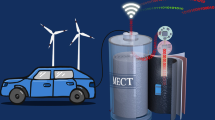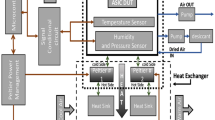Abstract
To increase the reliability of wireless-based monitoring systems under ionizing radiation environments, multiple diversified commercial off-the-shelf (COTS) modules have been used to achieve radiation tolerance. This paper presents experimental results of radiation tests on key modules in wireless-based monitoring systems, which include analog signal processing circuits, analog-to-digital converter (ADC) modules, microcontroller modules, and wireless transmission modules. In total, 12 modules have been evaluated, (i.e. 3 analog modules, 3 ADCs, 3 microcontrollers, and 3 wireless transmission modules). The radiation tests are conducted using the gamma radiator at The Ohio State University Nuclear Reactor Lab (OSU-NRL). The performance parameters of these 12 modules are investigated under high dose rate (20 krad(Si)/h). Experimental results have shown that the tested modules perform satisfactorily with little sign of degradation until the total dose levels reach the tolerable limits for these modules. Experimental results support the fact that, by using diversified COTS components, one may be able to achieve equivalent performance as those built by using radiation-hardened components, but with a considerable cost-saving. Furthermore, the tests also show that digital modules, particularly, with higher speed processors (i.e. microcontrollers) may be more susceptible to radiation than other types of modules. Therefore, additional shielding should be used to protect them.






Similar content being viewed by others
References
Ronald PL, Johnston AH, Azarewicz JL (1988) Radiation testing of semiconductor devices for space electronics. Proceeding of the IEEE 76:1510–1526
Yang I, Yoshinor M, Ryo I, Kenji T (2013) Development of mobile radiation monitoring system utilizing smartphone and its field tests in Fukushima. IEEE Sensors Joournal 13:3520–3526
Wilson CW, Atkinson GM (2014) Passive wireless sensor applications for NASA’s extreme aeronautical environments. IEEE Sensor Journal 14:3745–3753
Benfica J, Green B, Porcher BC, Poehls LMB, Vargas F, Medina NH, Added N, de Aguiar VAP, Macchione ELA, Aguirre F, Silveira MAG, Perez M, Haro MS, Sidelnik I, Blostein J, Lipovetzky J, Bezerra EA (2016) Analysis of SRAM-based FPGA SEU sensitivity to combined EMI and TID-imprinted effects. IEEE Trans Nucl Sci 63:1294–1300
Barnard A, Steyn WH (2007) Low cost TID testing of COTS components. In: Proc. 9th European Conference on Radiation and Its Effects on Components and Systems, 10–14 Sept. Deauville, France
Menicucci A, Malatesta F, Capua FD, Campajola L, Casolaro P, Furano G, Mascio SD, Ottavi M (2018) Simplified Procedures for COTS TID Testing: A Comparison Between 90Sr and 60Co. In: Proc. IEEE radiation effects data workshop (REDW), 16–20 July Waikoloa Village, HI, USA
Srour JR, Palko JW (2013) Displacement damage effects in irradiated semiconductor devices. IEEE Transactions on Nuclear Science 60:1740–1766
Fleetwood DM (2013) Total ionizing dose effects in MOS and low-dose-rate-sensitive linear-bipolar devices. IEEE Transactions on Nuclear Science 60:1706–1730
Ferlet-Cavrois V (2013) LW. Massengill, P. Gouker. “Single event transients in digital CMOS – a review”. IEEE Trans Nucl Sci 59:1767–1790
Proakis JG, Salehi M (2008) Digital Communications, Fifth edition. McGraw-Hill Higher Education
Holmes-Siedle A, Adams L (2002) Handbook of radiation effects, Second edn. Oxford University Press Inc., New York
Huang Q, Jiang J (2018) A radiation-tolerant wireless monitoring system using a redundant architecture and diversified commercial off-the-shelf (COTS) components. IEEE Trans Nucl Sci 65:2582–2592
Johnston AH, Swift GM, Rax BG (1994) Total dose effects in conventional bipolar transistors and linear integrated circuits. IEEE Trans Nucl Sci 41:2427–2436
Boch J, Saigne F, Schrimpf RD, Fleetwood DM, Ducret S, Dusseau L, David JP, Fesquet J, Gasiot J, Ecoffet R (2004) Effect of switching from high to low dose rate on linear bipolar technology radiation response. IEEE Trans Nucl Sci 51:2896–2902
Pease RL, Cohn LM, Fleetwood DM, Gehlhausen MA, Turflinger TL, Brown DB, Johnston AH (1997) A proposed hardness assurance test methodology for bipolar linear circuits and devices in a space ionizing radiation environment. IEEE Trans Nucl Sci 44:1981–1988
Pease RL, Gehlhausen M, Krieg J, Titus J, Turflinger T, Emily D, Cohn L (1998) Evaluation of proposed hardness assurance method for bipolar linear circuits with enhanced low dose rate sensitivity (ELDRS). IEEE Trans Nucl Sci 45:2665–2672
Sternberg AL, Massengill LW, Hale M, Blalock B (2006) Single-event sensitivity and hardening of a pipelined analog-to-digital converter. IEEE Trans Nucl Sci 53:3532–3538
Kalshnikov OA, Demidov AA, Figurov VS, Nikiforov AY, Polevich SA, Telets VA, Maljudin SA, Artamonov AS (1998) Integrating analog-to-digital converter radiation hardness test technique and results. IEEE Trans Nucl Sci 45:2611–2615
Lee CI, Johnston AH (1998) Comparison of total dose responses on high resolution analog-to-digital converter technologies. IEEE Trans Nucl Sci 45:1444–1449
Lee CI, Rax BG, Johnston AH (1994) Total ionizing dose effects on high resolution (12/14-bit) analog-to-digital converters. IEEE Trans Nucl Sci 41:2459–2466
Lee CI, Rax BG, Johnston AH (1995) Hardness assurance and testing techniques for high resolution (12- to 16-bit) analog-to-digital converters. IEEE Trans Nucl Sci 42:1681–1688
Method 1019.4 – “Ionizing Radiation (total dose) Test Procedure”, MIL-STD-883 for Microcircuits TM 1017, Department of Defense, United States of America
Acknowledgments
This work is financially supported by the University Network of Excellence in Nuclear Engineering (UNENE) and the Natural Sciences and Engineering Research Council of Canada (NSERC).
Author information
Authors and Affiliations
Corresponding author
Additional information
Responsible Editor: S. Mir
Publisher’s Note
Springer Nature remains neutral with regard to jurisdictional claims in published maps and institutional affiliations.
Rights and permissions
About this article
Cite this article
Huang, Q., Jiang, J. & Deng, Y.Q. Evaluation of Ionizing Radiation Effects on Device Modules Used in Wireless-Based Monitoring Systems. J Electron Test 36, 499–508 (2020). https://doi.org/10.1007/s10836-020-05890-5
Received:
Accepted:
Published:
Issue Date:
DOI: https://doi.org/10.1007/s10836-020-05890-5




